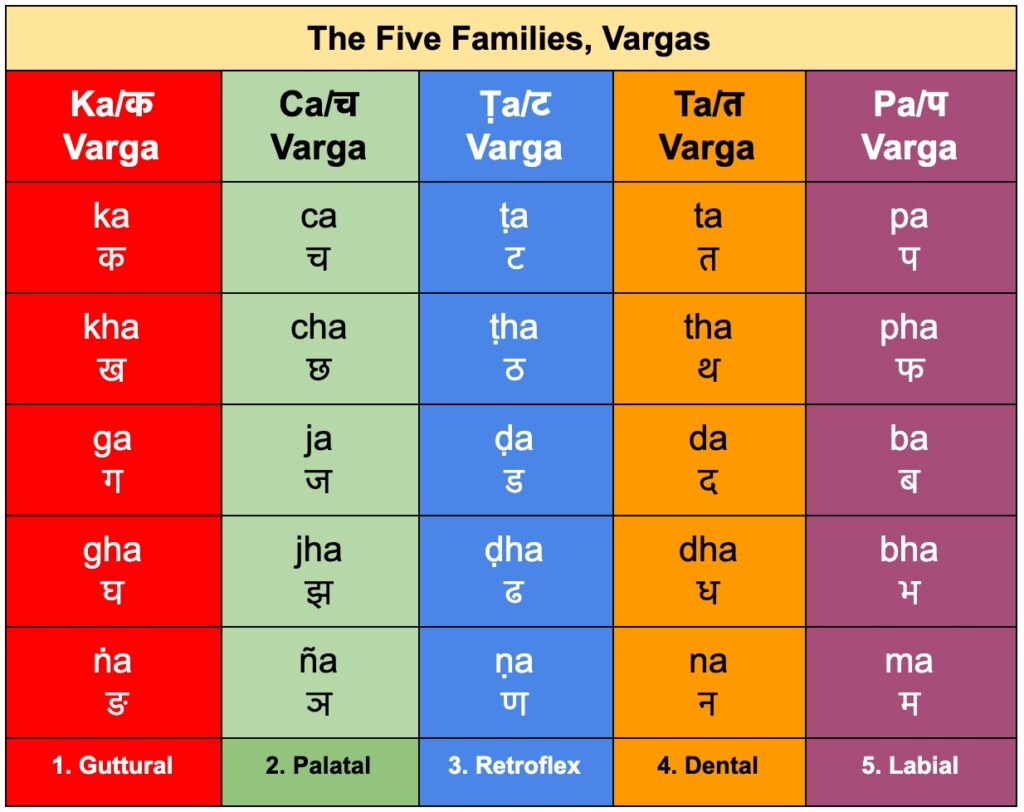

• 1 Stānas of the Five Vargas
• 2 Ka Varga, Guttural, Position 1
• 3 Ca Varga, Palatal, Position 2
• 4 Subtleties of Ca Varga
• 5 Ṭa Varga, Retroflex, Position 3
• 6 Ta Varga, Dentals, Position 4
• 7 Pa Varga, Labials, Position 5
• 8 Nasals, Anunāsika
Lesson 1: Stānas of the Five Vargas
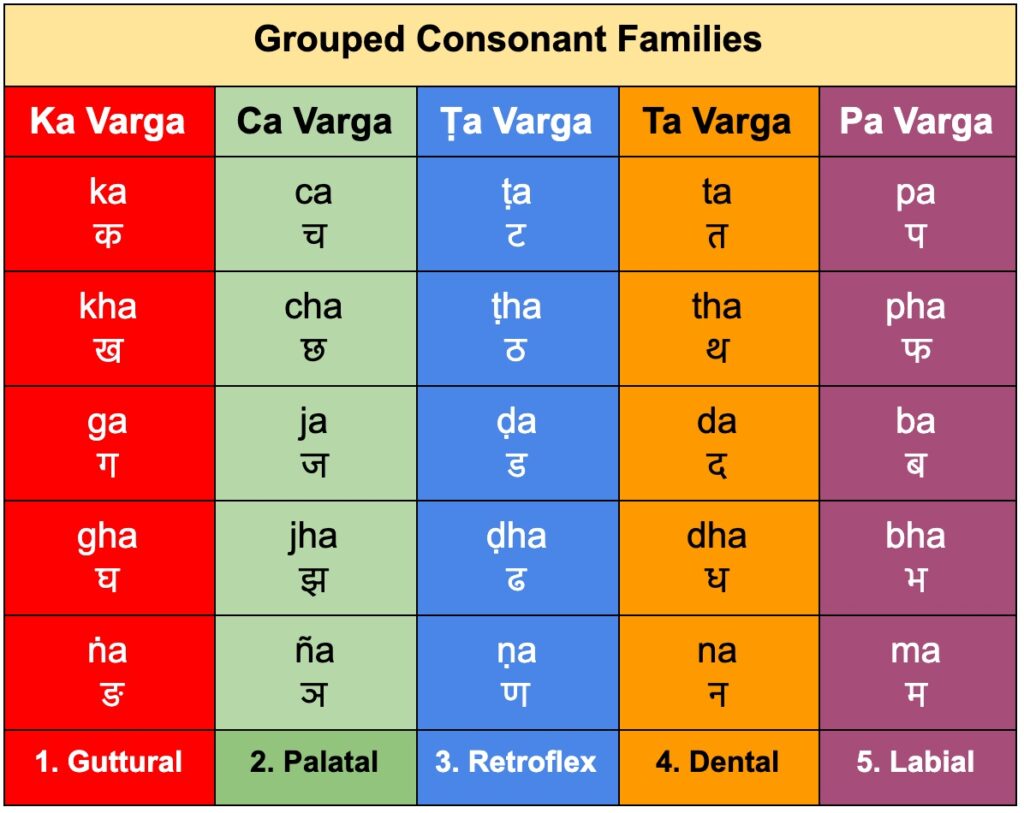
In this lesson we present the five families of grouped, or primary, consonants (vargīya vyañjana), as shown in colored columns in the table above. Each family, or varga, contains five letters and is named by the first letter in the group. The five vargas are distinguished by their stāna, or point of articulation in the mouth, as shown in the illustrations.
Ka (क) Varga is guttural (kaṇṭhya), sounded in the throat using the back of the tongue.
Ca (च) Varga is palatal (tālavya), sounded with the tongue held down and the tip of the tongue at the base of the lower row of front teeth. This forces the sound to hit the roof of mouth at position 2.
Ṭa (ट) Varga is retroflex (mūrdhanya), sounded with the tip of tongue at the front roof of the mouth.
Ta (त) Varga is dental (dantya), sounded with the tip of the tongue at the back of the front teeth.
Pa (प) Varga is labial (oṣṭhya), sounded at the lips, with no action of the tongue.
The first letter in every varga is the unvoiced unaspirated letter of the group. The second through fifth letters of each varga are variations of the first sound of the varga, created by using the same point of articulation but adding 1) aspiration, 2) voicing, 3) aspiration plus voicing and 4) nasalization. See chapter two for more detail on this progression.
InDepth: You may wonder why only the stop akṣaras are grouped in the vargas and not the other letters that originate from the same region of the mouth (semivowels, for instance). The reason is that the stop letters of each varga share the exact same position of tongue or lips as well as point of articulation; whereas for the non-śparṣa letters originating in these areas (the sibilants, aspirant and semivowels), the tongue or lips only come near (or approximate) these positions, in most cases without the tongue or lips actually touching the position used by these letters.
Exercise 3.1.1
Below the grouped consonants are organized in columns rather than rows. Following along with the audio, repeat them slowly being mindful of the difference in feel of the articulation points and the way the different parts of the tongue touch the spaces inside the mouth. Repeat these letter groups over and over. Work on them again and again, striving to perfect their pronunciation. Becoming adept at each letter group and each letter is the only pathway to excellent chanting, moving your tongue deftly, swiftly from one position to another as the akśaras present themselves for recitation. There is no shortcut.

ka — kha — ga — gha — ṅa
Pronounce the guttural letters (column one) and feel the sound of each letter vibrate in your throat.
ca — cha — ja — jha — ña
Pronounce the palatal letters (column two). Be aware of the sound striking the roof of your mouth as you hold the tongue down, with the tip of the tongue at the base of the lower front teeth.
ṭa — ṭha — ḍa — ḍha — ṇa
Pronounce the retroflex letters (column three: those with the dot underneath), consciously touching the tip of the tongue to the front roof of the mouth as you sound the letter.
ta — tha — da — dha — na
When you pronounce the dental letters (column four), touch the tip of your tongue to the back of your upper front teeth.
pa — pha — ba — bha — ma
When you pronounce labial letters, note that the sound is made by the action of the lips with no action of the tongue.
Exercise 3.1.2

In this exercise, we practice chanting the rows of letters, rather than the columns. Here is the progression:
1. unvoiced/unaspirated
2. unvoiced/aspirated
3. voiced/unaspirated
4. voiced /aspirated
5. nasal
6. assorted
As you listen to the audio and chant along, pay special attention to the points of articulation for each akṣara in the groups of five. Note that in each set, we move from position one (guttural) to position five (labial) and then from position five to position one. Perform this exercise at least ten times per group. With experience, you can also try saying the syllables quickly. As a way to speed up your pace, try adjusting the playback speed of the audio, 125% or 150%. The value of this practice cannot be overstated. Below is the text for the audio, for following along, or practicing on your own.
Pronounce the letters of row one in the table above
guttural to labial: ka — ca — ṭa — ta — pa
labial to guttural: pa — ta — ṭa — ca — ka
Pronounce the letters of row two
guttural to labial: kha — ch — a — ṭha — tha — pha
labial to guttural: pha — tha ṭha cha kha
Pronounce the letters of row three
guttural to labial: ga — ja — ḍa — da — ba
labial to guttural: ba — da — ḍa — ja — ga
Pronounce the letters of row four
guttural to labial: gha — jha — ḍha — dha — bha
labial to guttural: bha — dha — ḍha — jha — gha
Pronounce the letters of row five (nasals)
guttural to labial: gha — jha — ḍha — dha — bha
labial to guttural: bha — dha — ḍha — jha — gha
Assorted letters: Pronounce the mixed groups of letters below (taken from various rows) but still in order from Ka Varga to Pa Varga (guttural to labial) and from Pa Varga to Ka Varga.
guttural to labial: kha — ja — ṭa — dha — pa
labial to guttural: pa — dha — ṭa — ja — kha
Lesson 2: Ka Varga, Guttural, Position 1

Pronouncing the Ka Family of Letters
The Guttural Group, Position 1
ka, kha, ga, gha, ṅa
The best way to learn the sparśa consonants is to practice pronouncing them in their family grouping, or varga. The first group, the gutturals, is called the Ka Varga (red column above).
Exercise 3.2.1
Repeat the English words below, paying particular attention to the points where the targeted letters occur. Begin by repeating the example word a few times, noticing the part that corresponds to the Sanskrit letter. Next, try to say the Sanskrit letter independent of the word, for example runni “n”g and then ṅa.
ka like the k in skate (the initial s softens the letter k,
which is commonly aspirated in English)
kha like the k in Kate or kh in inkhorn
ga like the g in gate or go
gha like the gh in doghouse
ṅa like the n in sing
Exercise 3.2.2
Repeat the following words with the audio. All the consonants in these words are from the Ka Varga. Notice how the tongue stays mostly in the same area, only moving to pronounce the different vowels.
As you listen to the audio and pronounce these akṣaras, note how the root of the tongue naturally touches the back of the throat, position 1, guttural.
Words with consonants from Ka Varga only
aṅka — khaga — aṅgaka
aṅgha — gaṅgā — khaṅga
Next, repeat the following two sets of words with the audio. These words begin or end with a letter from Ka Varga but also use consonants from other vargas. Notice how in these two sets, the non Ka Varga consonants originate from different locations.
Words with only the starting consonant from Ka Varga
kathā — khaṇḍa — gītā — ghaṇṭā
kapāla — kham — ghaṭa
Words with only the ending consonant from Ka Varga
sukha — bhaṅga — śaṅka
mukha — dugha
Lesson 3: Ca Varga, Palatal, Position 2

Pronouncing the Ca Family of Letters
The Palatal Group, Position 2
ca, cha, ja, jha, ña
The five palatal letters (green column above) are ca, cha, ja, jha and ña. They are pronounced (or sounded) from the middle of the tongue, with the tongue held down, and the tip of the tongue below the lower front teeth. As the letter is pronounced, the sound is sent back and up to impact the hard palate at the roof of the mouth.
For many English speakers, it can be difficult to pronounce ca and ja with the middle of the tongue. In English, these letters are generally pronounced with the tip or front part of the tongue, rather than the middle, with the point of impact further forward than the palate. Also in English, the ca and ja sounds are given a slight hissing sound at the end, more like the aspirated ca and the aspirated ja.
Because of these habits, it takes intent and practice to pronounce these two letters in the true palatal Sanskrit manner, the difference being in trying to keep the tip of the tongue down, and using the blade/middle of the tongue when pronouncing.
To “find” the palatal letters, try the following exercise. Start by pronouncing the vowel i or the semivowel ya, both of which are placed at the palate. Then try to pronounce ica while keeping approximately the same position of the tongue for ca as for the vowel i. This can also be done with śa, by trying to pronounce śca again, keeping the tongue in approximately the same position as ś while saying ca. The same can be done for the Sanskrit ja by replacing the ca with ja in these practices. With this technique, you should gradually learn to properly say ca, cha and ja.
Exercise 3.3.1
Paying close attention to the audio, repeat the English words below, paying particular attention to the points where the targeted letters occur. Begin by repeating the example word a few times, noticing the part that corresponds to the Sanskrit letter. Next, practice saying the Sanskrit letter independent of the word.
c like the ch in church
(with less air than is usually spoken in English)
ch like the ch in chain
(using more breath than the last example)
j like the j in jump
jh like the geh in hedgehog or like the j in jump
(using more breath than the last example)
ñ like the n in cinch
Exercise 3.3.2
Again with the audio, repeat the following words, which only contain consonants from the Ca Varga. Try to notice how the tongue stays mostly in the same area, only moving to pronounce the vowels. Next, with the audio, repeat the second and third sets of words. These words begin or end with a letter from Ca Varga but also use consonants from other vargas. Notice how in these two sets, the non Ka Varga consonants originate from different locations.
As you emulate the teacher’s pronunciation of these akṣaras, hold the tip of the tongue below the lower front teeth so that the stem or middle of the tongue raises up to touch position 2 (palatal).
Words with consonants from Ca Varga only:
cañca — jhiñjhī — ciñcā
jhañjhā — jañja
Words with only the starting consonant from Ca Varga:
cakra — jagat — chatra — cheda
jita — japa — jhaṇa
Words with only the ending consonant from Ca Varga:
mañca — kroñca — piccha
aṇḍaja — majja
Lesson 4: Subtleties of Ca Varga
Difficulty with pronouncing Sanskrit palatal letters is common. The first issue is that most English speakers rarely pronounce a palatal ca or ja. However, to fulfill the Sanskrit system of dividing the sounds into specific points of articulation, the somewhat unfamiliar palatal stop that fits the scheme properly must, with effort, be learned.
A simple way to try to learn the palatal letters is to purposefully hold the tip of the tongue near the lower gums and try to pronounce the sound ca or ja. The result will likely be that you correctly pronounce the letters with the middle of your tongue, further back in the mouth than you would if you used the tip of the tongue (as is sometimes taught). This is how palatals are properly pronounced. This is a little bit of an exaggeration of the tongue position, but it helps us learn to switch from pronouncing with the tip of the tongue, as is done with the retroflex letters (position 3), to the middle of the tongue for the palatals.
In Sanskrit, and in general, the pronunciation of ya and i are both also placed as palatal. Hence they should have approximately the same mouth and tongue positions as the palatal consonants. It should become clear with a little experimenting that i and ya are pronounced with the middle of the tongue, rather than the tip.
A simple practice to observe this is to say ci with both forms of pronunciation: 1) trying to bring the tip of the tongue back to the hard palate, 2) using the middle of the tongue as explained above.
After trying both, you will probably notice that with the tip-of-the-tongue method, the tongue leaves the position of ci when you begin saying i, naturally showing that they have different places of articulation (though according to the Sanskrit system they should be in the same place).
When you use the middle of the tongue to say ci, you will likely find that the tongue stays in relatively the same position, just retracting slightly from the hard palate to make the vowel sound. This naturally shows that they have the same point of articulation, as it should be in the consistent Sanskrit system.
Exercise 3.4.1
In-Depth: Technical insights on Ca
The common English cha (as in the word change) only slightly uses the palate, and is affricate (making a slight hissing sound like sh at the end). This variation is used by many native speakers of Indian languages as well these days. (https://en.wikipedia.org/wiki/Voiceless_postalveolar_affricate).
(see here for a linguistic perspective on cha: https://en.wikipedia.org/wiki/Voiceless_palatal_stop).
Notice again the location of position 2 in the above graphic. That is the point of articulation for the palatal letters, such as ca and ja. The most common mistake is using position 3 for ca (which is the position of the retroflex letters, such as ṭa).
In this lesson, with the audio, practice moving back and forth between these two vargas, making the tongue position of ca distinctly palatal by holding the tip of the tongue behind the lower front teeth and arching up the middle of the tongue to touch the roof of the mouth.
ṭa ca ca ṭa
ḍa ja ja ḍa
You can also use the guttural letters to get the idea of the palatals by going back and forth between the two vargas. The guttural letters (which engage the back of the tongue) are similar to the palatals in that they do not use the tip of the tongue in pronunciation, and are further back than the other vargas.
ka ca ca ka
ga ja ja ga
The vowel i and the semivowel ya are sounded at the same position as ca and ja. Try the following sounds. When done correctly, the positions of the tongue will be the same, except that ca and ja will make contact with the roof of the mouth while ya will only come near it:
iya ica ica iya
iya ija ija iya
Exercise 3.4.2
Following along with the audio, pronounce the following words. Each contains letters from the guttural and palatal stānās, which means you do not use the tip of the tongue, only the middle or the back. This exercise should help you get a firmer hold on how to pronounce the palatal letters.
jaga chāga kāciñcika
kākaciñci ciñci ciñca
kaja gaja picchikā
icchā gaccha yaccha kīja
Now try each of the palatals coupled with various vowels:
ca ci cu cha chi chu
ja ji ju jha jhi jhu
Once you feel comfortable with the palatal letters, try the following words to challenge yourself:
jaṭa rāja jana pañca
caṇḍa chāyā chatra jvālā
yajvā jalaja jyeṣṭha jhaṇa
Lesson 5: Ṭa Varga, Retroflex, Position 3
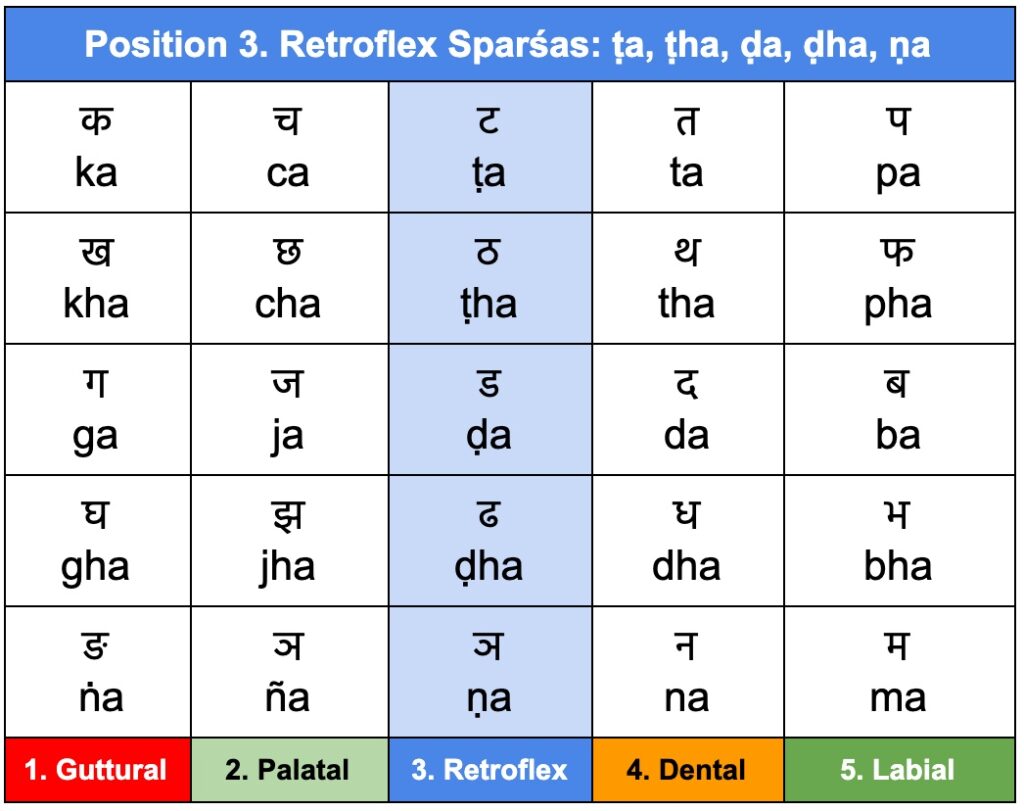
Pronouncing the Ṭa Family of Letters
The Retroflex Group, Position 3
ṭa, ṭha, ḍa, ḍha, ṇa
The retroflex (or cerebral) sparśa letters (blue column above) are pronounced in position three, at the roof of the mouth just behind the teeth. The tip of the tongue goes up to touch the hard palate, the bony region behind the gums. Most English dialects have a similar point of pronunciation, but for Sanskrit the tongue goes slightly further back—to the front roof of the mouth.
Exercise 3.5.1
Repeat the English words below, paying particular attention to the points where the targeted letters occur. Begin by repeating the example word a few times, noticing the part that corresponds to the Sanskrit letter. Next, practice saying the Sanskrit letter independent of the word.
ṭ like the t of star
ṭh like the t of tar or the th of anthill
ḍ like the d of dart
ḍh like the dh of madhouse
ṇ like the n in tint
Exercise 3.5.2
With the audio, repeat the following words that only contain consonants from the Ṭa Varga. Try to notice how the tongue stays mostly in the same area, only moving to pronounce the vowels. Next, with the audio, repeat the second and third sets of words which begin or end with a letter from Ṭa Varga, but also use consonant of another varga. Notice how in these sections, each consonant originates from a different location.
As you listen to the audio and practice these akṣaras, raise the tip or front of the tongue to touch position 3 (retroflex).
Words with consonants from Ṭa Varga only
aṭṭaṭṭa ḍiṇḍi ḍhuṇḍhi
ḍuṇḍa aṇḍa
Words with only the starting consonant from Ṭa Varga:
aṇḍaja ṭānta ḍānta
ḍamaru ṭhakkura
Words with only the ending consonant from Ṭa Varga:
daṇḍa kuṇḍa caṇḍa
bhaṇḍa viṣṇu
Lesson 6: Ta Varga, Dental, Position 4
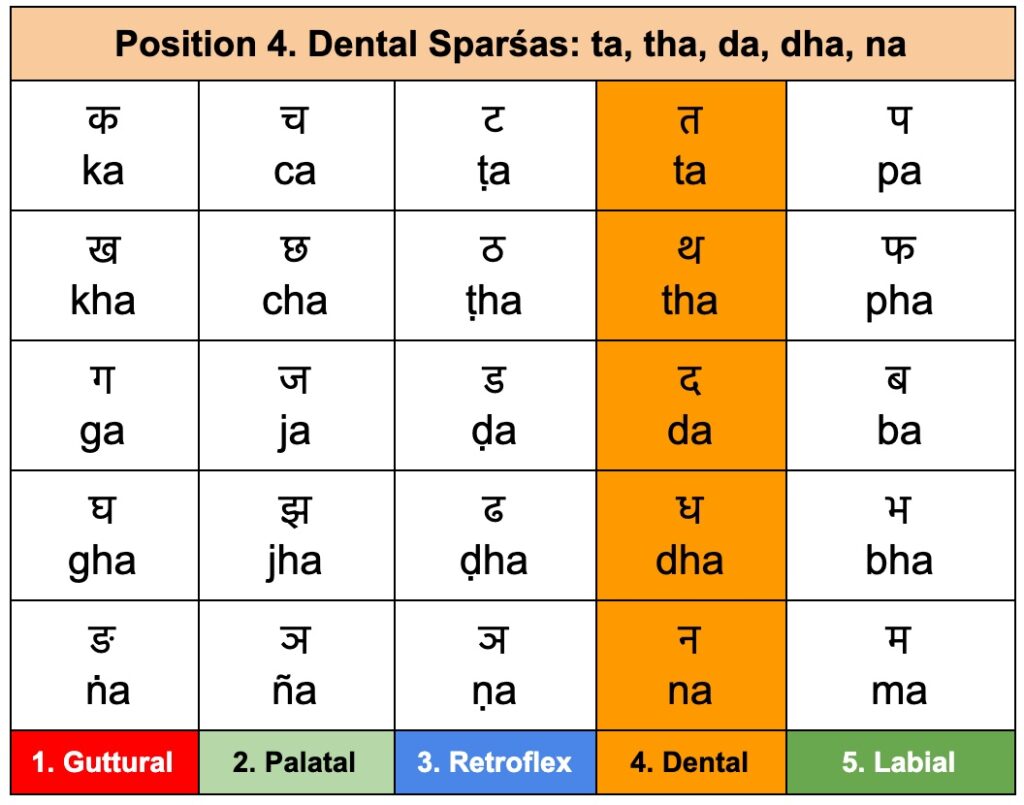
Pronouncing the Ta family of letters
- The Dental Group, Position 4
For the dental sparśā letters (orange column above), the tongue touches the back of upper front teeth near the gums.
In some English dialects the use of the dental letters will be natural, but this is not the case for most North American dialects. The only letter that is consistently dental in English dialects is the English th (as in through or that). Here are some ways to find the dental letters in the mouth, or to ascertain if you already pronounce them as dental:
Begin to say a word that begins with a simple t like ten. At first say the word, and see if you can tell whether the tongue touches the upper teeth; if it does, dental letters are natural to you. If the tongue remains a little further back, not touching the upper teeth, you will need to practice.
Note: Here we are using the example of t, but the position of the tongue is the same for all the dental letters.
Here is another method for finding the dental letters:
Begin to say the sound ta (or the word ten), but stop before pronouncing the vowel, so that the tongue begins to assume the position of the t. Now, observe where the tongue is. It should be touching the upper front teeth. If not, slide the tongue forward to touch that point, and release your ta sound. This is a dental t. It may take some time to hear how this dental t is different from a more retroflex t, but for now practice this position.
Note: In an alternate method for the dentals, the tongue touches between the upper and lower teeth, even slightly protruding through them.
Exercise 3.6.1
Repeat the English words below, paying particular attention to the points where the targeted letters occur. Begin by repeating the example word a few times, noticing the part that corresponds to the Sanskrit letter. Next, practice saying the Sanskrit letter independent of the word.
As from our above discussion, these examples may or may not be dental in your dialect, but they are important for understanding the difference between aspirated and unaspirated variations of the letters.
t like the final t of start
th like the first t of tart or the th of anthill
d like the d of dart
dh like the dh of madhouse
n like the n in tint
Exercise 3.6.2
With the audio, repeat the following words that only contain consonants from the Ta Varga. Try to notice how the tongue stays mostly in the same area, only moving to pronounce the vowels. Next, following the audio, repeat the second and third sets of words which begin or end with a letter from Ta Varga but also contain a consonant of another varga. Notice how in these sections, each consonant originates from a different location.
As you listen to the audio and strive to replicate the teacher’s pronunciation, be sure that the tip or front of your tongue touches the back of the upper front teeth, position 4, which is dental.
Words with consonants from Ta Varga only
tathā — datta — tadā — tanā — dāna
dhanada — dhanu — danta — nanda — nada
Words with only the starting consonant from Ta Varga:
daṇḍa — tapa — tama — tuṅga
dhūma — nāga — nūpura
Words with only the second consonant from Ta Varga:
kānta — dānta — manda — rādhā — bandha
Lesson 7: Pa Varga, Labial, Position 5
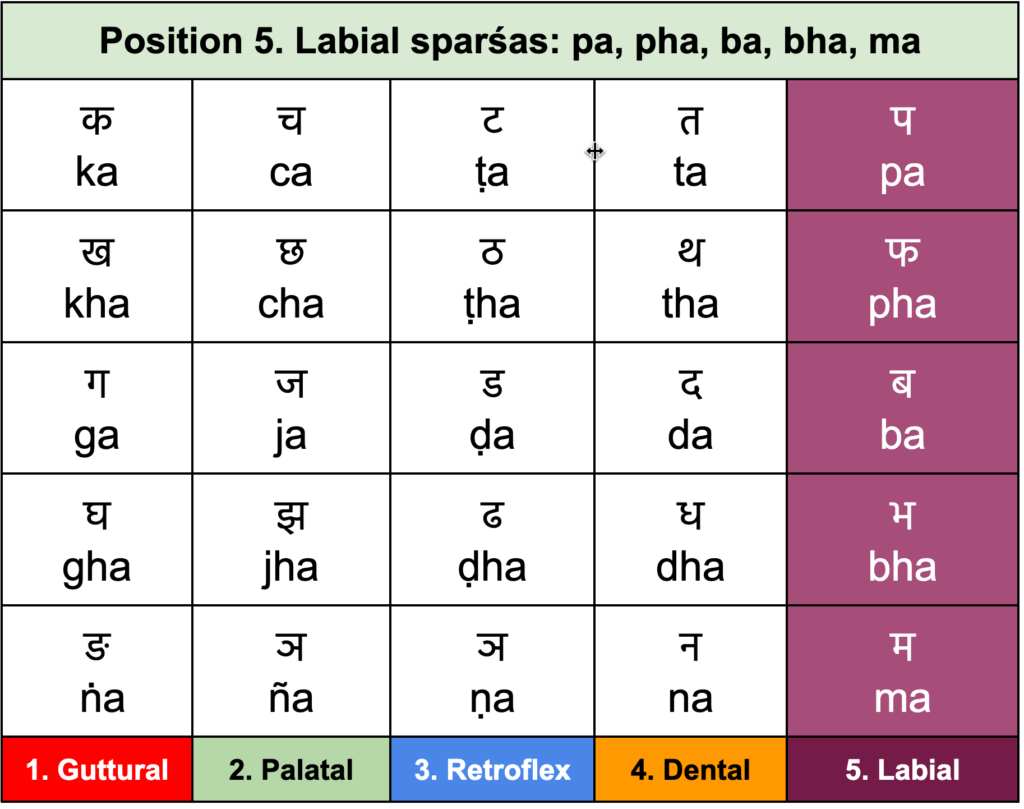
Pronouncing the Pa Family of Letters
The Labial Group, Position 5
pa, pha, ba, bha, ma
The labial sparśas are the simplest sounds to pronounce. They require no action of the tongue. Hence, they are naturally the first sounds that an infant makes when learning to speak, e.g., ma ma, ba ba, pa pa.
Exercise 3.7.1
Repeat the English words below, paying particular attention to the points where the targeted letters occur. Begin by repeating the example word a few times, noticing the part that corresponds to the Sanskrit letter. Next, practice saying the Sanskrit letter independent of the word.
p – like the p in spin
ph – like the p in pin or path
b – like the b in bin
bh – like the bh in labhouse
m – like the m in mumps
Exercise 3.7.2
Repeat, with the audio, the following words which only contain consonants from the Pa Varga. Try to notice how the tongue stays mostly in the same area, only moving to pronounce the vowels. Next, with the audio, repeat the second and third groups of words, which begin or end with a letter from Pa Varga, but also use a consonant of another varga. Notice how in these sections, each consonant originates from a different location.
As you listen to the audio for these letters, note how the lips work to create the sounds at position 5 (labial).
Words with consonants from Pa Varga only:
amba bimba bhāma bhīma
Words with only the starting consonant from Pa Varga:
pātra pāda padma pati bandha
Words with only the ending consonant from Pa Varga:
kampa dambha lamba sāmba
tāpa jambha tama
Lesson 8
The Nasals, Anunāsika

Five of the 25 sparśa consonants are referred to as nasals as they are pronounced by redirecting air up through the nose. Each varga has one nasal akṣara. The five nasals are: ṅ, ñ, ṇ, n, m.
The nasal sounds are most easily learned by pairing them with a consonant from their own varga. In this way, one can see what nasal naturally precedes a consonant from a certain varga. With time and practice, pronouncing the correct nasal becomes natural, because it is natural. For example, you will get into a flow of always using the guttural nasal (ṅ) before the guttural ka.
However, especially for beginners, it is quite possible to pair incorrect nasals with the consonant of another varga. This usually happens when we default to the familiar dental n sound instead of allowing the mouth to accommodate the position of the consonant that follows the nasal letter. An example of this mistake would be to pronounce the word gaṅga like the English word gun + ga.
Pronouncing nasals incorrectly can also affect the pronunciation of the following consonant as well. This is especially true if there is a similar but different letter in our native language. For example, piñca might be said like the English pinch, which uses a dental n and affricate ch rather than the proper Sanskrit sounds. Another common example is using the dental English n in words with retroflex letters, for example, making daṇḍa more like danda.
Of the five nasals, the palatal ñ and guttural ṅ almost never occur as independent letters. They usually occur as accommodating nasal sounds for consonants of their own vargas (ṅga, ṅka, ñca, ñja, etc).
Exercise 3.8.1
1. Pronounce the following words along with the audio. Pay careful attention to making the distinct sounds of the different nasals, so you do not fall back on the familiar English sounds.
retroflex, position 3: daṇḍa
(Hint: if you are NOT actually pronouncing the retroflex ṇ, you will be saying danda, which sounds like the English done + da)
guttural, position 1: gaṅga
(Hint: if you are NOT pronouncing this correctly, you will be saying ganga, which sounds like the English gun + ga)
palatal, position 2: piñcha
(Hint: if you are NOT pronouncing this correctly, it will sound just like the English pinch + a)
Exercise 3.8.2
Play the following audio files for each exercise, repeating each word in the list below after it is spoken by the teacher.
1. Pronounce the following groups of words, each containing only one kind of nasal letter. After each set of words, try to say the nasal letter independently of the word, both with a vowel preceding it, and then following it. Use the words in each set to help you isolate the nasal letter.
m म —labial (position 5)
ambā lamba ambhas
kumbha am ma
n न —dental (position 4)
anta panthā nanda
randha an na
ṇ ण —retroflex (position 3)
arṇa ghaṇṭa kaṇṭha aṇḍa ṣaṇḍa
aṇ ṇa aṇa
ñ ञ —palatal (position 2)
pañca piñcha añji jhañjha
añ ña aña
ṅ ङ —guttural (position 1)
aṅka śaṅkha aṅga saṅgha
aṅ ṅa aṅa
2. Say each of the nasal letters coupled with different vowels:
ma mi mu
na ni nu
ṇa ṇi ṇu
ña ñi ñu
ṅa ṅi ṅu
3. Follow the audio in saying these words which involve more than one nasal or slightly more difficult pronunciation situations.
anna annena. anaṅga
anaṅgāṇḍa rāmeṇa anañjana
daṇḍena. viṣṇunā. maṇi
maṇinā āmnāya mantreṇa
